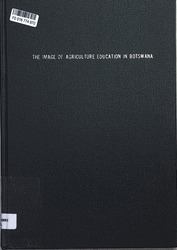The image of agriculture education in Botswana
Abstract
This study examines agricultural education in Botswana among students and teachers. Since independence in 1966 to the present time, agricultural production has declined from about 40 percent to about 3 percent. Harsh climatic conditions and a general ignorance about agriculture contribute to the restricted perception of agriculture and careers in this field. Individual and focus group interviews were conducted with agricultural teachers who had resigned and former graduates in four secondary schools and three postsecondary educational institutions (Botswana College of Agriculture, University of Botswana, and Tonota College of Education). Negative, positive and mixed images emerged that revealed some similar and some contradictory perceptions of agriculture education. The attrition of teachers also attracted attention because of their working conditions and their images of agricultural teaching. However, the phenomenon of teacher attrition is not unique to agriculture.
Students and teachers had conflicting images concerning curriculum instruction. Teachers identified the inadequacy of practicals because students are unable to apply the theoretical knowledge they have acquired to satisfy the various skills required in their new jobs. On the other hand, students perceived practicals as misdirected intensive labour. Non-agricultural tertiary students demonstrated that they do not have a full understanding of the potential career opportunities that agriculture can provide. They often thought that agriculture was confined to ploughing and food production. Nevertheless, both agricultural students and non-agricultural students agreed that agriculture could be a good career that they might consider later in their lives.
Participants in the study suggested strategies to enhance the poor perception of agriculture education in educational institutions in Botswana. One strategy was for curriculum reform, such that agriculture teaching should reinforce practicals that are relevant to students’ needs. Practical instruction should not be used as intensive manual labour but should be used to target specific skills that are needed in industry. Agriculture teaching should start at primary school so that pupils can develop a positive image towards agriculture education at a young age, at the age of seven students could be involved in simple experiments conducted in laboratories, then at eleven years students can start practicals in the garden, making sure not to overwork the pupils.
Through career guidance and counselling, agricultural teachers should broaden the limited perception that agriculture is simply food production and expand the field to its scientific and commercial careers, such as food processing and marketing. Even though the Ministry of Agriculture provides some incentives to farmers, they misappropriate the schemes. Access to loans has to be provided for students who have completed their studies and cannot find jobs so that they can also join the field of production.
Even though women are dominated by men in both agriculture and in education and food production in Botswana, this trend is changing; there are more female enrolments in agricultural educational institutions than males. The government is trying to create an equitable distribution of resources for women as well. The position of women in Botswana is better than what literature has revealed in sub Saharan Africa.
Collections
- Theses and Dissertations [133]

